Pelvic tilt exercise: Health Benefits, Variations, How to Do?
What is pelvic tilt exercise?
- This pelvic tilt exercise helps to strengthen your abdominal muscle and helps to stretches your lumbar spine.
- This exercise is used to correct the alignment of lumbar spine with lordosis and pelvic tilt .
- It is helps to relieve chronic low back pain.this activate intrinsic muscle of core.
- Which reduce strain over back.
- For this you have to Lie on your back on the ground with your both knees bent.
- Flatten your back against the ground by tightening your abdominal muscles and move your pelvis up slightly.
- Hold for up to ten seconds
- An anterior pelvic tilt may be caused by a sedentary lifestyle or poor posture while long time sitting.
- Prolong sitting may cause tightness of the muscles that flexed the hip (iliopsoas and rectus femoris) and extend the lower lumbar spine (lumbar erector spinae)which cause an anterior pelvic tilt.
- Posterior pelvic tilt is a movement in which the front of the pelvis upward and the back of the pelvis drops downward.
- While the pelvis rotates upwards.
- A posterior pelvic tilt can occur due to bad posture.
- When prolong sitting at a computer (or other sitting activity).
- Which causes tightness in the hip flexors and hamstrings and it cause weakness of abdominal muscles.
- Lateral pelvic tilt is asymmetric positioning of the pelvis where your one waist height is higher than the another side this called as hip hike or one waist height is lower than the another side this is called as Hip drop.
- It is also called as uneven hips.
- Lateral pelvic tilt is occurs due to tightening and shortening on the adductors, gluteus medius, and quadratus lumborum on one side of the body and weakening and lengthening of same muscle on the another side.
- The most obvious symptoms occurs due to lateral pelvic tilt is uneven walk or altered gait due one hip dropping,poor posture.
- lateral pelvic also occurs due to weak gluteus maximus and abdominal muscles.
- Left side pelvic tilt : Left side pelvic tilt is occurs when your right side of the pelvis is elevated higher than the left side.
- Right side pelvic tilt : Right side pelvic tilt is occurs when your left side of the pelvis is elevated higher than the right side
Health benefits of pelvic tilt exercise:
- Helps to strengthen your abdominal muscles .
- Tighten your abdominal muscles.
- Helps to relieve chronic lower back pain.
- Help to achieve flatter abs.
- Helps to increasing strength of pelvic floor muscle.
- Help to reduce lumbar lordosis induce by bad posture.
- Pelvic tilts are a safe way to work your abdominal muscles and stretch out the base of your spine.
- Helping relieve pelvic pain.
- Recommended at all stages of pregnancy for relieve back and pelvic pain.
There has lots of Benefits Doing Pelvic Tilt Exercise during Pregnancy:
- It will help to prevent or treat gestational diabetes.
- Helps to improving your mood.
- Aids in toning the muscles.
- It will improve strength and endurance.
- Improves stamina and energy.
- Helps to improve your posture.
- Relieve from Constipation.
- Decrease swelling over foot.
- Help to relieve back pain.
- Helps to improve your strength for cope with labor.
- Some doctors also advice pelvic tilts to induce labor.
- Will help your body and abdomen get back in normal shape faster after delivery.
How to do pelvic tilt exercise?
Anterior pelvic tilt correction exercise:
Basic pelvic tilt
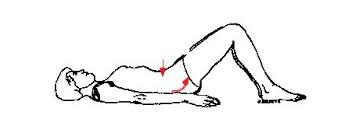
- For this you have to lie on your back with both feet flat on the floor and your knee flexed 60 degrees.
- Now you have to press your low back against the floor by tilting pelvis backwards.
- On breath in you have to relax your lower back over the ground by tilting the pelvis forward.
- You have to try only to move the lumbar spine.
- Once you master in basic pelvic tilt, you will progress the move and add in movement.
- Add the movement will force your core to work harder to stabilize.
Progression in pelvic tilt exercise:
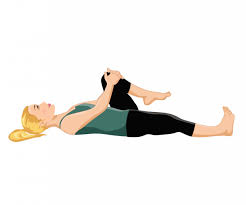
Pelvic tilt march
- you have to lie on your back with his feet flat on the floor and your knee flexed 60 degrees.
- Now you have to press your low back against the floor while exhaling by tilting pelvis backwards.
- Once you have engaged your abs ad tilted your pelvis you have raise one foot up from the ground.
- Bringing your knee towards your chest touch your foot down to the ground.
- When you bring your knee towards your chest,your low back firmly on the ground.
- Now repeat this for another knee.
- When you confident in this then you become increase a speed of doing this exercise.
- Repeat this for 3 to 4 sets with a 10 to 15 second break in between.

Pelvic tilt with double knee
- For this exercise you have to do basic pelvic tilt first then keeping your both knee towards your chest.
- Move slowly and make sure to keep your lower back against the ground as you lift your both knees.
- If at any part of the movement you feel your abs are not engaged and your lower back not firmly press into ground.
- Then go for starting position and just practice pelvic tilt march once you expertise in that movement then go for it.
- It is more important to do qualitative movement rather then progression.
- Repeat this for 3 to 5 sets with a 10 to 12 second break in between.
Pelvic tilt with single leg lowers or scissor ab exercise
- For this exercise you have to engage your abs for basic pelvic tilt and elevate your both leg towards the ceiling.
- Try to engage your abs and your back press towards ground.
- Now take your one leg down to the ground at this movement your abs will harder to stay engaged.
- Our goal is to lower the leg so that your heel is just hovering off the ground.
- When you lower the leg make sure you have to engage your abs and glute as well.
- Then keeping the leg straight, and elevate again.
- Now put another leg down.
- You can also increase range of motion as you become better able to activate your core muscle.
- If at any point your low back not press firmly then go for easy variation of pelvic tilt like double knee tuck.
- Repeat this for 3 to 4 sets with a 10 to 12 repetition .
Pelvic tilt with double leg lowers or leg lower ab exercise
- For this exercise you have to engage your abs for basic pelvic tilt and elevate your both leg towards the ceiling.
- Try to engage your abs and your back press towards ground.
- Now take your both leg down to ground at this movement your abs will harder to stay engaged.
- our goal is to lower the leg so that your heel is just hovering off the ground.
- When you lower the leg make sure you have to engage your abs and glute as well.
- If at any point you feel your low back off the ground stop doing this variation of pelvic tilt and go for easier way like double knee tuck and scissor abs exercise.
- Either you decrease the range of motion.
- Make sure that your both leg should straight as you can throughout the motion.
- With all of these progressions, you can place a towel under your low back to help make sure you are press your back down to the ground.
- It place exactly under your low back and then engage your abs and glutes with the Pelvic Tilt exercise.
- Repeat this for 3 to 4 sets .
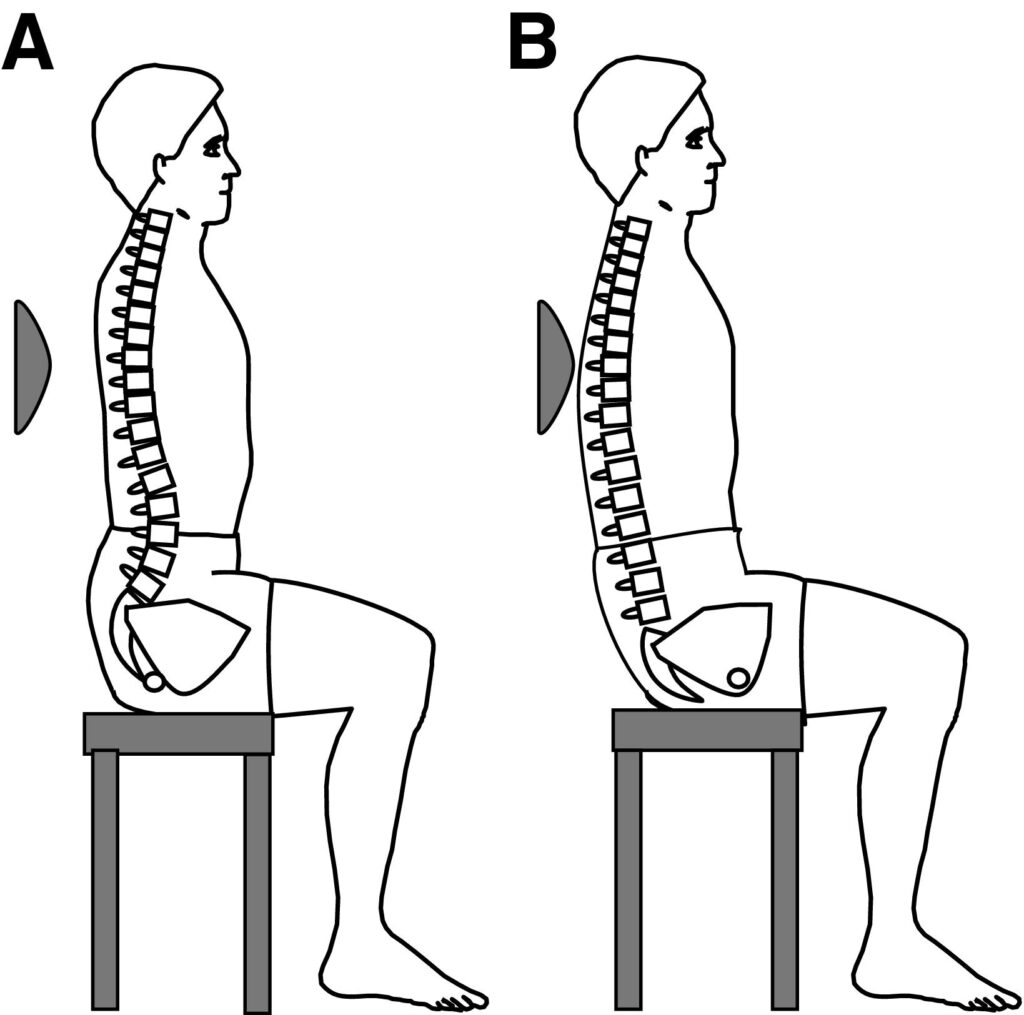
Seated Pelvic Tilts
- For doing this exercise you need one table of the medium size.
- You should be able to sit on it with your hip slightly above then your knees.
- When you are seated on a table.first you take a deep breath in and your foot and shoulder are in wide base off support.
- Take help from your core muscle to maintain posture and balance on table.
- Now you have to breath out and tuck your tail bone in rolling slightly forward on the table.
- Now you take deep breath in as you press your tailbone backward and forward away from your foot and back to starting position
- Do five to ten repetition in one session.
- Repeat this for 3 to 4 sets daily with 10 to 12 repetition.
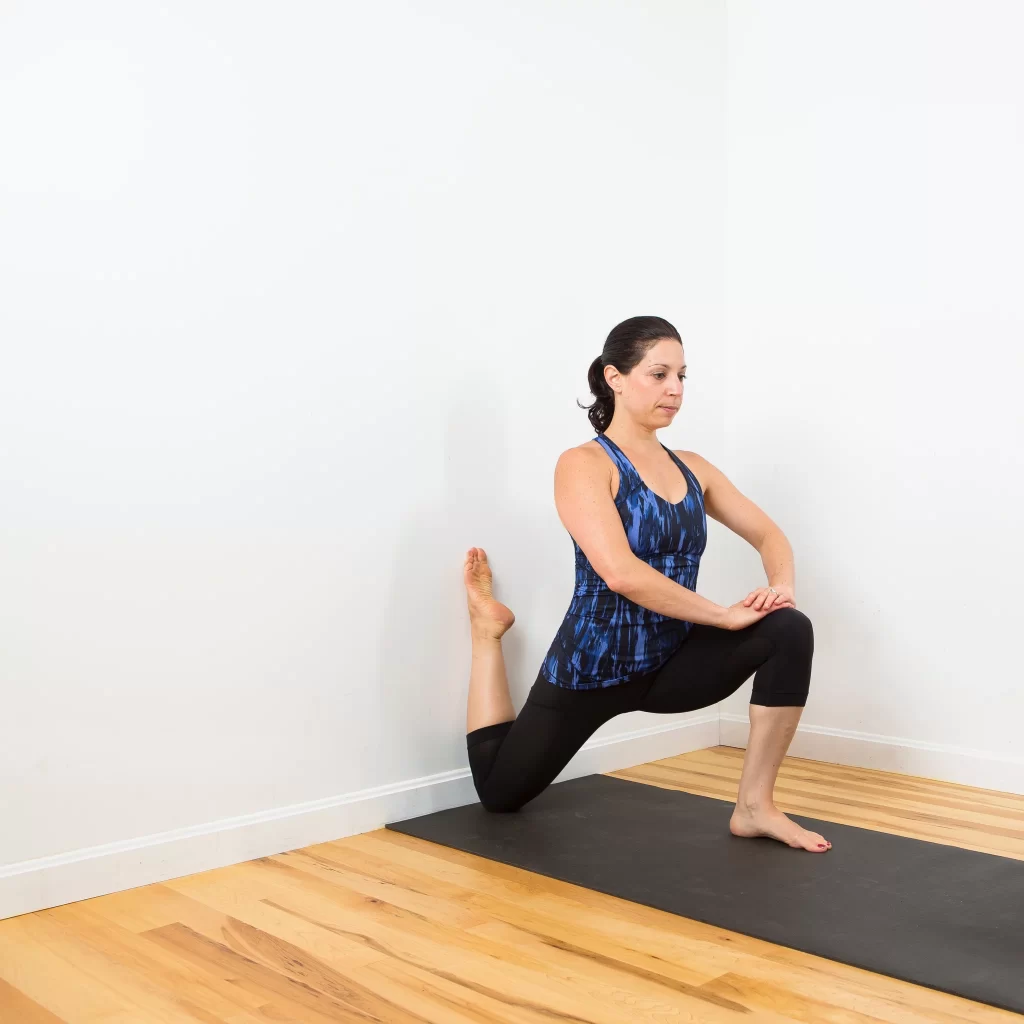
Half-kneeling hip flexor stretch
- This exercise will help to relax the hip flexors and increase your hip joint mobility.
- Step your left leg out in front of you and lunge until your right knee is resting on the wall.
- Place a towel under your knee if this is uncomfortable.
- Your left leg should make a 90-degree angle at your knee.
- Bring your pelvis forward by tightening your gluteus and abdominal muscles.
- Lean forward from your right leg until you feel tension in the hip flexor and inner thigh of your right leg
- Hold for 30 seconds, release, and repeat up to 5 times.
- Do this for another leg.

Bridging exercise :
- This exercise will help to strengthen your hamstrings and your gluteus muscles.
- Lie on your back with both knees bend 90 degree feet flat.
- Breath out and lift your bottom of back up from the floor.
- Keep your thighs and inner feet parallel.
- Your spine should form a straight line from your shoulders to your knees.
- You may rest your arms with hands palms down by your sides them together and extend them along the floor beneath you.
- Hold for 10 seconds to 1 minute.
- Now take down your back to the floor and repeat this for 5 to 10 times in one session.
- You also do this exercise three times a day.
Kneeling leg lift with back stretch
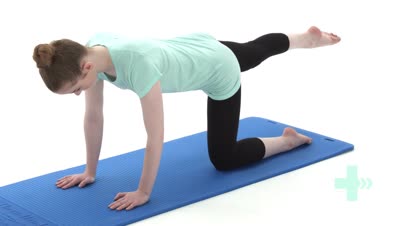
- This exercise will help to tighten your core muscle and help to stretch your back and your gluteus muscles.
- Take a quadruped position with your hands and knees get down.
- Place your hands on the floor shoulder-width apart. put your hip and your knees in a straight line.
- Make sure your back is parallel to the ground so your pelvis is in a neutral position.
- Pull your belly button in toward your spine and arch your back as you breath out.
- Hold for 2 to 4 seconds, and then bring your spine back to the neutral position.
- Extend one leg back and elevate it until it reaches the same height as your body, so your lifted leg and body are in same alignment.
- Try to maintain your spine in a neutral position.
- Hold this position for 5 to 6 seconds, lower the leg, and repeat for 10 times.
- Now do this for another leg.
- This exercise will help to strengthen your abdominal and gluteus muscles and your back muscles.

Squats
- This is a full-body exercise that helps to strengthen your gluteus muscles, hamstrings, and quadriceps muscles with others also.
- take down your whole body like a sitting position until your both thighs are parallel to the floor.
- Make sure you are keeping your abdominal muscles tight and your back in a neutral position.
- Push up to a standing position and move your pelvis slightly forward by tightening your gluteus muscles.
- Repeat this for 18 to 20 times.
Posterior pelvic tilt correction exercises:
Leg lunges
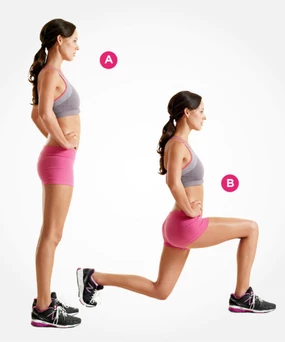
- Lunges strengthen your glutes, quadriceps, and hamstring muscle.
- For this you have Stand on a floor with feet together and step your right leg forward in front of you.
- Bend the left leg at a ninety-degree angle.
- Your left knee should touch the floor with your right leg still at a 90-degree angle.
- A mirror can help you to check your body alignment and position.
- Push off your left foot to return to the starting position
- Step forward with your left leg and form a 90-degree angle to touch your right knee to the floor.
- Repeat for 3 to 4sets of 12–15 lunges.
Static hamstring stretch
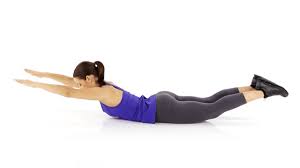
- You have to Sit in a hard chair without a cushion, and stretch out one leg in front of you.
- Your upper body Bend down and reach for your toes until you feel a slight stretch.
- Hold for 15–30 seconds.
- Repeat for the other leg .do this for three times.
Superman stretch
- It will help to strengthen your lower back and gluteus maximus muscles which is connected to your pelvis.
- For this you have Lie on the floor on your tummy and stretch your hands out in front of you.
- Lift both arms and leg off the floor and try to hold this position for 30to 35 seconds.
- Then take down arms and legs.
- Repeat this for 3 to 4 sets with a 10 to 12 second break in between.
Leg raises
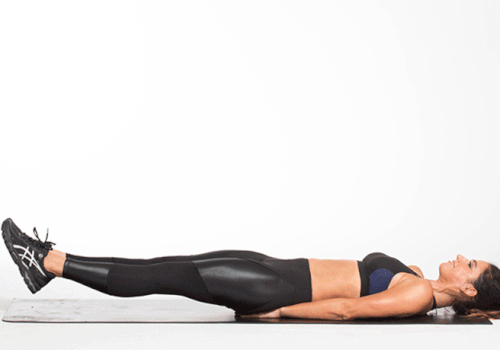
- Leg raises is a very simple exercise you can do it for strengthen your core.
- Which gives your body the ability to stand up straighter.
- You can also practice crunches in place of leg raises to build your core muscle.
- For this exercise you have to lie on the floor with your both leg straight.
- Slowly raise your legs from the ground as high as you can without allowing your lower back to arch off the floor.
- Slowly take both legs down.
- Keep your arms flat right next to your body.
- You will not to move any part of your body except your legs.
- This is how you will develop your core muscles, and pelvic in neutral position .
lateral pelvic tilt correction exercises:
You also try this exercises at home to correct a lateral pelvic tilt

Reverse leg raises
- This exercise help to strengthen your gluteus muscles , improve hip flexibility.
- You have to lie on your stomach (prone position). your both legs are resting on a ground.your head resting on your hands.
- Elevate one leg keep knee straight through out the movement.
- Your one leg resting on the ground.elevated leg hold this position for 5 to 7 seconds ten lower down the leg.
- Do 12 to 15 repetition on one leg then go for another leg.
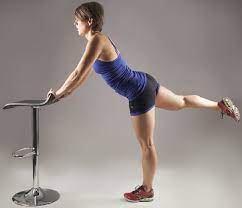
Reverse standing leg raises
- This exercise help to strengthen your gluteus muscles and improve your balance.
- You have standing near a wall or hold one chair in your hand for balance.
- Stand straight and ,engaged your abdominal muscle and lift right leg off the floor behind you.
- Keep leg straight behind you as high as possible with comfort and without putting pressure on your back.
- Hold this position for 5 to 10 seconds,repeat it floor 10 to 15 times,now do this exercise for left leg raise behind you.

Hip hike
- Hip hike is helpful to improve hip and core muscle and improve pelvic alignment.
- You have to stand straight and take one step stool on your right side.
- Your right leg put on a stool and your left leg free on air ,now you have to move your left leg up and down.
- Your whole body weight put on a right leg. do this movement for 10 seconds.
- Return to starting position and repeat for 8 to 10 times. do this for another leg.
Clamshell

- Clamshell exercise will help improve your hip mobility and strengthen your gluteus muscles.
- For this exercise you have to lie down your right side with your both knee ninety degree angle,and your bottom hand supporting your head.
- Your both hip slightly flexed.your spine should be relaxed and stable.
- Lift your left knee towards ceiling but your foot keep together,you only move knee.
- Hold this for 5 to 10 seconds.then lower down.
- Do 10 repetition on one leg then switch the side.
- Make sure you have to maintain your spine straighten not to rotate.
Hip adduction
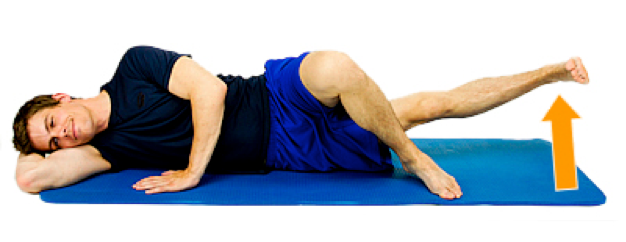
- Hip adduction exercise will help to strengthen your adductor muscles, which are located on the inner side of your thigh.
- For this exercise you have to lie down your right side with your both knee ninety degree angle,and your bottom hand supporting your head.
- Your spine should be relaxed and stable.cross your left leg with right leg,your right leg should be straight.
- Lift your right leg up from the ground as you can comfortable.hold for 5 to 10 seconds.
- Do this movement for another leg side.during this move you are not turning your hips.
Side Plank

- This is an excellent exercise for your lateral side pelvic tilt .
- It is also helpful to strengthen the obliques and deep spinal stabilizing muscles, as well as hips and shoulder muscle.
- You will start on your prominent side.
- You have to hold your upper body on your bottom of elbow with your hand out in front of you for maintaining balance.
- Your elbow should be directly under your shoulder.
- Your both legs put together for touching your heels now raise your hips into the air by engaging your core and glutes.
- If you feel balanced, try to elevating your top arm towards the ceiling or you can rest it on your upper hip.
- Repeat this exercise move on the another side.
- To modify, keep your bottom knee on the ground for extra support.
- Try to hold this position for 20 to 30 seconds.
Complication occur due to altered pelvic:
- Tension in the cervical muscles
- Low back pain
- Inward rotation of the hip joint and knee joint
- Hip and knee pain
- Pressure on hip flexor muscle cause sciatica symptoms
- Gait altered
When you not to do this exercise?
- If you have severe back pain.
- If you feel any pain during exercise.
- if you have just delivered after pregnancy
- if you are healing from any surgery injury of your back, abdomen, pelvis, hip joints, knees, or ankles
- if Your Doctor refused to do exercise
- if exercise will increase your symptoms

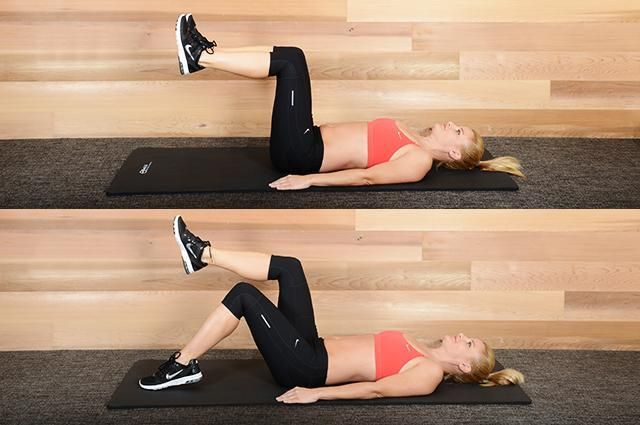





2 Comments